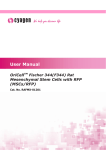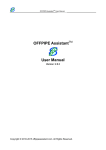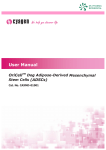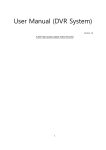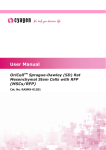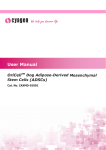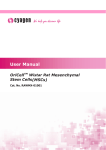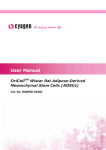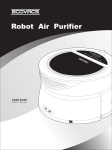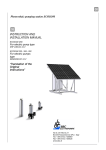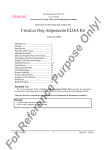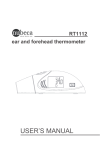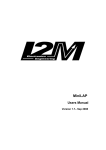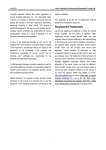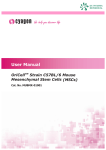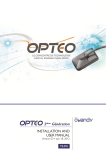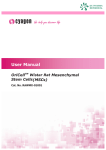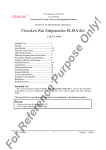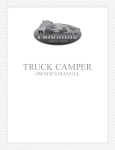Download User Manual
Transcript
User Manual OriCellTM Strain C57BL/6 Mouse Mesenchymal Stem Cells with GFP (MSCs/GFP) Cat. No. MUBMX-01101 Table of Contents Contents and Storage …………………………………..……………………………………………………3 Product Introduction ……………………..……….……………..…………………………………3 Cell Characteristics and Identity ……………..………………………..…………………………3 Product Application ……………………………………………………………..……………………4 General Handling Principles ……………………………………………………………..……………4 Culturing OriCellTM Strain C57BL/6 Mouse MSCs/GFP Thawing and Establishing OriCellTM Strain C57BL/6 Mouse MSCs/GFP………………………4 Passaging Cyagen OriCellTM Strain C57BL/6 Mouse MSCs/GFP…………………...……………6 Differentiation of OriCellTM Strain C57BL/6 Mouse MSCs/GFP……………..…….……………7 Cryopreservation of OriCellTM Strain C57BL/6 Mouse MSCs/GFP …………….……..…12 Appendix …………………………………………………………………………………. 13 Troubleshooting ……………………………………………………………………………………………… 13 Related Products ……………………………………………………………………………………………14 References ……………………………………………………………………………………………………14 Technical Support ……………………….………………………………………………15 CONTENTS AND STORAGE Product Name Strain C57BL/6 Mouse Mesenchymal Stem Cells with GFP Catalog No. MUBMX-01101 Amount per Vial 1×106 Cells Cryopreserved At Ninth Passage Storage Condition Liquid Nitrogen CAUTION: Please handle this product as a potentially biohazardous material. This product contains dimethyl sulfoxide (DMSO), a hazardous material, in the freezing medium. PRODUCT INTRODUCTION Mesenchymal stem cells (MSCs) are multipotent stem cells that can differentiate into a variety of cell types including osteocytes, adipocytes, and chondrocytes. MSCs proliferate quickly and are capable of generating a local immunosuppressive microenvironment, thus contributing to their wide application potentials in tissue engineering, cell therapy, and gene therapy. OriCellTM C57BL/6 Mesenchymal Stem Cells with GFP are derived from the bone marrow of C57BL/6 mice, cultured as monolayer, and then have been transfected with a lentiviral construct containing a GFP expression motif. They have a strong capacity for self-renewal while maintaining their multipotency. In addition, these cells have been tested for: • Exogenous Factors: bacterial/fungal contamination, mycoplasma contamination, and endotoxin contamination. • Characteristics: post-thaw viability, cell cycle, verification of undifferentiated state, and differentiation potential. This product is intended for laboratory research use only. It is not intended for diagnostic, therapeutic, clinical, household, or any other applications. CELL CHARACTERISTICS AND IDENTITY • Strong capacity to expand. Can be passaged at least 5 times. IMPI0073A2 MUBMX-01101 Page 3 of 14 • n ability along the oste eogenic, cho ondrogenic c, and Multipotent diffferentiation ogenic linea ages. adipo • 29, CD44, C CD31, and Sca-1 (> 70%), 7 and negative fo or Posittive for CD2 CD117 (< 5%) in flow cyttometry ass says. PRODUC CT APPL LICATIO ONS Sttrain C57BL L/6 Mouse MSCs/GFP have becom me a popular research h target due to th heir potential use in re egenerative e medicine and tissue engineering g (in areas such as s cardiovascular, neura al, and orth hopedic disease). OriCellTM Stra ain C57BL//6 Mouse M SCs/GFP ca an be used as cell mo odels to eva aluate the mmunoreactions, proliferation, im mmigration,, and differentiation o f MSCs botth in vivo im an nd in vitro. GENERA AL HAND DLING PRINCIP P PLES 1.. Aseptic handling h of the producct is necess sary througho out. 2.. Once the e cells have been estab blished, alw ways freeze e several vi als of OriCe ellTM Strain C5 57BL/6 Mou use MSCs/G GFP as a ba ackup. N Note: The O OriCellTM Str rain C57BL L/6 Mouse e MSCs/GFP can be frrozen/thaw wed at le east two tim mes. 3.. For all studies, it is strongly re ecommende ed to use ce ells that are e at, or und der, an p number of 10 0. original passage 4.. For general mainten nance of ce ells, we reco ommend th he seeding density to be m2. 2.0-3.0×104cells/cm 5.. For general mainten nance of ce ells, we reco ommend th hat the med dium is cha anged dicator in the medium m appears y yellow). In if it becomes acidic (the pH ind e growth m edium everry three days. general, change the 6.. Do not le et OriCellTM C57BL/6 M MSCs/GFP overgrow o as s it will resu ult in contact inhibition n. When the e cells are 8 80-90% confluent, subculturing the cells is strongly recommend ded. N Note: We sttrongly reco ommend th he use of Or riCellTM cult ture media and other re elated reage ents for optimal resullts. THAWIN NG AND D ESTABLISHIN G OriCe ellTM Stra ain C57B BL/6 Mo ouse MSCs/G GFP M Materials Required R IMPI0073A2 M MUBMX-01101 Page 4 of 14 • OriCellTM Mouse Mes senchymal Stem Cell Growth Medium (Cat. No.MUXMX X-90011) hawing and a Estab blishing S train C57 7BL/6 Mo ouse MSCs s/GFP Th 1. Pre-warm m the fully supplemen s ted (complete) OriCelllTM Mouse M MSC Growtth Medium to 37°C. 2. Add 9 mL L of OriCellTM Mouse M MSC Growth h Medium to a 15 mL conical tub be. 3. Remove the cryovia al of OriCelllTM Strain C57BL/6 C Mo ouse MSCs//GFP from liquid nitrogen.. 4. Quickly thaw t the via al in a 37°C C water batth until the last ice cry ystal disapp pears. For optim mal results, be sure to o finish the thawing prrocedure wiithin 3 minutes. Be carefu ul not to su ubmerge th e entire via al. Maximu um cell viab bility is dependent on the ra apid and co omplete tha awing of fro ozen cells. ess than op ptimal if the e cells are thawed t forr more than n3 N Note: Resultts will be le m minutes. 5. As soon as a the cells s are complletely thawed, disinfec ct the outsiide of the cryovial with w 70% v/v v ethanol . 6. Use a pip pette to transfer the ccells to the 15 mL coniical tube co ontaining OriCellTM Mouse MSC Growth M Medium inside a biosafety cabine et. Be care eful not to introduce any bubbles durin ng the trans sfer process. 7. Rinse the e vial with 1 mL of the e medium to t reduce cell loss. Su bsequently y transfer this t 1 mL of o cell suspe ension into the conical tube. 8. Gently mix m the cell suspension n by slowly pipetting up u and dow wn. Be carefful not to introduce any bubbles. 9. Centrifug ge the cell suspension s at 250 x g for 5 minu utes. 0. Carefully y aspirate off as much of the supernatant as s possible a and add 2-3 3 mL 10 TM of fresh OriCell O Mo ouse MSC G Growth Med dium (pre-w warmed to 37°C). 11 1. Gently re esuspend th he cells in O OriCellTM Mo ouse MSC Growth G Med dium. 12 2. Seed the e cells into a T25 flask k and add a sufficient amount a of OriCellTM Mouse M MSC Growth Medium m. Gently rock the cu ulture flask to evenly d distribute the t cells. 13 3. Incubate e the flask at a 37°C ins ide a 5% CO C 2 humidiffied incubattor. 14 4. The nextt day, chang ge the med dium with fresh growth medium ((pre-warme ed to 37°C). 15 5. Change the t growth medium ev very three days thereafter. 16 6. When the e cells are approximattely 80-90% % confluent, they can n be dissociated with Tryp psin-EDTA and a passag ged. N Note: Chang ging Mediium 1.. Warm an n appropriatte amount of medium to 37°C in a sterile co ontainer. Replace the t spent medium m witth the pre-w warmed, fresh medium m. Once complete ed, return the flask to the incuba ator. 2.. Avoid rep peated war rming and c cooling of the medium m. If the en ntire conten nt is not needed for a sin ngle proced dure, transffer only the e required v volume to a sterile se econdary co ontainer. IMPI0073A2 M MUBMX-01101 Page 5 of 14 Fig. 1. OriCellTM Strain C57BL/6 Mouse Mesenchymal Stem Cells with GFP are established. PASSAGING OriCellTM Strain C57BL/6 Mouse MSCs/GFP Materials Required • 0.25%Trypsin-0.04%EDTA (Cat. No. TEDTA-10001) • Phosphate-Buffered Saline (1×PBS) (Cat. No. PBS-10001) • OriCellTM Strain C57BL/6 Mouse Mesenchymal Stem Cells with GFP (Cat. No. MUBMX-01101) • OriCellTM Mouse Mesenchymal Stem Cell Growth Medium (Cat. No. MUXMX-90011) Passaging OriCellTM Strain C57BL/6 Mouse MSCs/GFP 1. Pre-warm the OriCellTM Mouse MSC Growth Medium, 1×PBS, and 0.25%Trypsin0.04%EDTA solution to 37°C. 2. Carefully aspirate the spent medium from the 80-90% confluent monolayer of MSCs. 3. Add 1×PBS (6 mL for T75 flask, 3 mL for T25 flask). Be careful not to disturb the monolayer. Gently rock the flask back and forth to rinse the monolayer. 4. Aspirate 1×PBS off and discard. 5. Repeat steps 3-4 two or three times. 6. Add 0.25%Trypsin-0.04%EDTA solution (2-3 mL for T75 flask, 1 mL for T25 flask). Gently rock the flask back and forth to ensure that the entire monolayer is covered with the Trypsin-EDTA solution. Allow trypsinization to continue until the majority of the cells (approximately 80%) are rounded up. At this point, gently tap the side of the flask to release the majority of cells from the culture flask surface. Important: Avoid leaving cells exposed to the trypsin longer than necessary (no more than two minutes if using Cyagen’s trypsin-EDTA solution). Care should also be taken that the cells are not forced to detach prematurely as this may result in clumping. IMPI0073A2 MUBMX-01101 Page 6 of 14 7.. After the cells are visibly v detacched, imme ediately add d the pre-w warmed OriCellTM Mouse MSC Growth Medium (6 6 mL for T7 75 flask, 3 mL m for T25 flask) to e the trypsinization. neutralize 8.. Gently piipette the medium m ove er the cells to dislodge e and resusspend the cells. c Repeat 5-6 times un ntil all the ccells are dis ssociated frrom the fla ask and eve enly d into a single cell susspension. dispersed 9.. Transfer the dissocia ated cells in nto a 15 mL m conical tu ube. 10 0. Centrifug ge at 250 x g for 5 min nutes. 11 1. Carefully aspirate off as much of the supe ernatant as s possible. T 12 2. Add 2 mL L of OriCellTM Mouse M MSC Growth h Medium to the coniccal tube and d gently re esuspend th he cells tho roughly. 13 3. Plate the cells into appropriate ain C57BL//6 Mouse a e flasks. OriCellTM Stra FP can be sp plit at 1:2 o or other ap ppropriate ratios. r MSCs/GF 14 4. Add an appropriate amount off medium to o the cells. Incubate tthe cells att 37°C 5 CO2 hu umidified in cubator. inside a 5% N Note: Care should be taken t to av void introdu ucing bubbles during pipetting. Additional Tips Tiime to Cha ange Mediium It is recomm mended to change c the culture me edium if the ere are too many dead d cells affter passaging. It is recomm mended to change c the culture me edium when never the m medium bec comes ac cidic, even if the cells do not rea ch 80-90% % confluency y. The pH iindicator in the cu ulture medium will app pear yellow w when acid dic. Tiime to Sub bculture W When OriCelllTM Strain C57BL/6 C Mo ouse MSCs//GFP are 80-90% con nfluent, it is re ecommende ed that the e cells be su ubcultured.. Do not lett the cells o overgrow as s it will re esult in contact inhibition. OriCellTTM Strain n C57BL/6 Mous se MSCs s DIFFERENTIA ATION USING T TM OriCell DIFFE ERENTIA ATION M MEDIA ain C57BL//6 Mouse M SCs/GFP ca an differenttiate into a variety of cell OriCellTM Stra ypes including osteocy ytes, adipoccytes, and chondrocyt c tes. ty O Osteogenic Differen ntiation M Materials Required R OriCellTM Mes senchymal Stem Cell O Osteogenic c Differentia ation Mediu um (Cat. No o. UXMX-9002 21) GU IMPI0073A2 M MUBMX-01101 Page 7 of 14 Osteogenes sis Protoco ol N Note: The protocol listed below iss for 6-welll tissue cultture platess. M 1.. Culture the OriCellTM Strain C5 57BL/6 Mou use MSCs/G GFP in OriCe ellTM ymal Stem Cell Growtth Medium at 37°C in a 5% CO2 humidified Mesenchy incubatorr. 2.. When cellls are apprroximately 80-90% co onfluent, they can be d dissociated d with 0.25%Try ypsin-0.04% %EDTA (Ca at. No. TED DTA-10001). 2 in 3.. Reseed the MSCs in n the growt h medium at 3×104 cells/cm c n a 6-well tissue oated with 0 0.1% gelatin solution. culture plate pre-co 4.. Incubate the cells at 37°C insi de a 5% CO2 humidiffied incubattor. 5.. When cellls are apprroximately 60-70% co onfluent, ca arefully asp pirate off the growth TM medium from each well and ad dd 2 mL of OriCell Mesenchyma M ell al Stem Ce nic Differentiation Med dium. Osteogen 6.. Feed cells every thrree days forr 2-4 weeks by completely replaccing the medium with h CellTM Mese enchymal S Stem Cell Osteogenic O Differentiat D tion Medium m (prefresh OriC warmed to t 37°C). 7.. After 2-4 4 weeks of differentiat d ion, cells ca an be fixed and staine ed with aliz zarin red S. event osteoblasts from m detaching g, it is recommended tto change half h of the No ote: To pre me edium everry two days s before ana alysis. Allizarin Red d S Stainin ng Analysiis 1.. After the cells have differentia ted, remov ve the osteo ogenic diffe erentiation medium from the wells w and rin nse with 1x x phosphate e-buffered ssaline (PBS S). Fix h 2 mL of 4% formalde ehyde solution for 30 minutes. cells with 2.. Rinse we ells twice wiith 1x PBS. Stain the cells with 1 mL alizarrin red S wo orking solution for f 3-5 min nutes. 3.. Rinse we ells 2-3 time es with 1x PBS. 4.. Cells can now be vis sualized an nd analyzed d under a microscope. m Fig g. 3 OriCellTM Strain C57BL//6 Mouse MSC Cs/GFP are diffferentiated in nto osteocytess and are stain ned witth alizarin red d S. IMPI0073A2 M MUBMX-01101 Page 8 of 14 Adipogenic Differen ntiation M Materials Required R OriCellTM Mes senchymal Stem Cell A Adipogenic c Differentia ation Mediu um (Cat. No o. GU UXMX-9003 31) Ad dipogenes sis Protoco ol N Note: The protocol listed below iss for 6-welll tissue cultture platess. M 1.. Culture the OriCellTM Strain C5 57BL/6 Mou use MSCs/G GFP in the O OriCellTM ymal Stem Cell Growtth Medium at 37°C in a 5% CO2 humidified incubator. Mesenchy 2.. When cellls are apprroximately 80-90% co onfluent, they can be d dissociated d with 0.25%Try ypsin-0.04% % (Cat. No o. TEDTA-10 000). 3.. Reseed the MSCs in n growth me edium at 2x104 cells/ /cm2 in a 6 6-well tissue e culture h a medium m volume o of 2 mL per well. plate with 4.. Incubate the cells at 37°C in a 5% CO2 humidified h incubator. 5.. Feed the cells every y three day ys until they y are 100% % confluent or post-confluent. Induction n of adipogenic differe entiation att post-confluency is sttrongly recommended d. 6.. When the e cells are 100% conffluent or po ost-confluen nt, carefully y aspirate off o the spent gro owth mediu um from the e wells and d add 2 mL of OriCellTMM Mesenchy ymal Stem Cell Adipogenic Differentiation medium A (induction medium) per well. 7.. Three days later, ch hange the m medium to OriCellTM Mesenchyma M al Stem Cell nic Differentiation med dium B (ma aintenance medium) b by complete ely Adipogen replacing g the spent medium A . 8.. 24 hours later, chan nge the me edium back to MSC Ad dipogenic D Differentiatio on medium m A. 9.. To optimally differentiate MSC Cs into adipo ogenic cells s, repeat th he cycle of induction ntenance att least three e times. and main M 10 0. After thre ee to five cycles of ind duction and d maintenance, culture e the cells in OriCellTM Mesenchy ymal Stem Cell Adipog genic Differentiation medium m B ffor an addittional 4-7 days until the lipid droplets d are e big, round enough. During the se days period, m every thre ee days. change the medium Oil Red O Stain S Analy ysis 1.. After the cells have differentia ted, remov ve the MSC maintenan nce medium m from the wells and rinse with 1x pho osphate-bu uffered salin ne (PBS). Fix cells with 2 % formaldeh hyde soluti on for 30 minutes. m mL of 4% 2.. Rinse we ells twice wiith 1x PBS and stain cells c with 1 mL of oil rred O working solution (3:2 ( dilutio on with dist illed water and filter with w filter p paper) for 30 3 minutes. 3.. Rinse we ells 2-3 time es with 1x PBS. 4.. Cells can now be vis sualized an nd analyzed d under a microscope. m IMPI0073A2 M MUBMX-01101 Page 9 of 14 TM Fig.4 OriCell Strain C57BL/6 Mouse MSCs/GFP are differentiated into adipocytes and are stained with oil red O. Chondrogenic Differentiation Materials Required OriCellTM Mesenchymal Stem Cell Chondrogenic Differentiation Medium (Cat. No. GUXMX-90041) Chondrogenesis Protocol 1. Calculate the total number of MSC pellet cultures required for your experiment (2.5×105 MSCs are needed to form each chondrogenic pellet). Transfer this amount of cells into an appropriate culture tube. 2. Wash the MSCs with Incomplete Chondrogenic Medium. Centrifuge the cells at 150 x g for 5 minutes at room temperature and then aspirate off the supernatant. Resuspend the cells in 1 mL of Incomplete Chondrogenic Medium per 7.5×105 cells. Centrifuge again at 150 x g for 5 minutes and then aspirate off the medium. 3. Resuspend the MSCs in Complete Chondrogenic medium to a concentration of 5.0×105 cells/mL. 4. Aliquot 0.5 mL (2.5×105 cells) of the cell suspension into 15 mL polypropylene culture tubes. Centrifuge the cells at 150 x g for 5 minutes at room temperature. DO NOT aspirate the supernatant or resuspend the pellet. 5. Loosen the caps of the tubes one half turn in order to allow gas exchange, and incubate the tubes at 37°C in a humidified atmosphere of 5% CO2. Do not disturb the pellets for 24 hours. 6. Feed the cell pellets every 2-3 days by completely replacing the medium in each tube (to avoid aspirating the pellets when aspirating the medium, attach a sterile 1-200μL pipette tip to the end of the aspirating pipette). Add 0.5 mL of freshly prepared Complete Chondrogenic Medium to each tube. 7. After replacing the medium, flick the bottom of the tube to ensure that the pellet is free floating. Loosen the caps and return the tubes to the 37°C incubator. 8. Chondrogenic pellets should be harvested after 14-28 days in culture. Pellets may be formalin-fixed and paraffin-embedded for alcian blue stain analysis. IMPI0073A2 MUBMX-01101 Page 10 of 14 Alcian Blue Staining Procedure 1. The tissue sample should be formalin-fixed and paraffin-embedded already. 2. Staining procedure: a) Deparaffinize slides and hydrate to distilled water. b) Stain in alcian blue solution for 30 minutes. c) Wash in running tap water for 2 minutes. d) Rinse in distilled water. e) Visualize under a light microscope and capture images for analysis. Blue staining indicates synthesis of proteoglycans by chondrocytes. TM Fig.5 OriCell Strain C57BL/6 Mouse MSCs/GFP are differentiated into cartilages and are stained with alcian blue. IMPI0073A2 MUBMX-01101 Page 11 of 14 CRYOPR RESERVA ATION OF O CELL LS USIN NG OriCe ellTM CRYOPR RESERVA ATION MEDIA M R Protein-F Free Cryoprreservation Medium (C Cat. No. NC CPF-10001) is a OriCellTM NCR use freezing g medium. Its chemically-define ed and protteinprrotein-free,, ready-to-u fre ee formulattion has be een optimize p cellls, thus gre eatly ed to stem cells and primary en nhancing th he viability and integriity of these e cells by prrotecting th hem from da amage during the one e-step freezze-thaw pro ocedure. Unlike otherr convention nal fre eezing med dia, which require r a sl ow program mmed freez ze, this pro oduct allows s the ce ells to be diirectly froze en at -80°C C. Cryopreservation ge the cultu ure medium m with fresh h growth medium m 24 h hours before N Note: Chang freezing. 1.. Collect ce ells that are e in the log garithmic grrowth phase. Perform m a cell coun nt to determ mine the via able cell de ensity. 2.. Centrifug ge the cells for 3-5 min nutes at 25 50 x g and 20°C. 2 Remo ove and discard th he supernatant using a pipette. 3.. Resuspen nd the cell pellet p in the e OriCellTM M NCR Prote ein-Free Cry yopreservattion Medium at a a cell density of 105 5-106 cells//mL. 4.. Dispense e aliquots off the cell su uspension in nto cryogen nic storage vials that are a properly labeled. 5.. Place the e vials direc ctly in a -80 0°C freezer. After 24 hours, h transsfer the fro ozen vials to liquid nitrogen for long g-term preservation IMPI0073A2 M MUBMX-01101 Page 12 of 14 4 APPENDIX Troubleshooting The table below lists some potential problems and solutions for culturing MSCs. Problem Low cell recovery rate Slow cell growth Cause Solution The storage condition does not meet the requirements Purchase a replacement and store in liquid nitrogen for long-term preservation. Thawing of the cells takes too long Thaw cells for no more than 3 minutes. Cells are incompletely recovered after thawing After aspirating off medium, wash the tube with culture medium twice and transfer all of the cells to the dish. Cells are handled roughly Care should be taken to avoid introducing bubbles during pipetting. Also avoid vortexing and high-speed centrifugation Medium is not pre-warmed Warm medium to 37°C before recovery. Mycoplasma contamination Discard the cells in question and disinfect the laboratory environment before recovering the next batch of cells. Over digestion Wash the cells with PBS 2-3 times to remove serum prior to trypsinization (serum will inhibit the function of trypsin). Control the digestion time. Cell aging IMPI0073A2 MUBMX-01101 Plating density is too low Increase the plating density. Inappropriate serum and medium Use Cyagen tailor-made culture media. If other serum and media products are used, please perform validation to ensure compatibility. Dead cells are not removed promptly Change the medium next day after recovery to ensure removal of all dead cells. Cell Contamination Discard the cells in question and disinfect the laboratory environment before recovering the next batch of cells. Plating density is too low Some stem cells can secrete factors to support cell growth. Therefore, a certain degree of plating density must be maintained; otherwise, it will lead to cell proliferation slow down and cell aging. Page 13 of 14 RELATED PRODUCTS Product Catalog Number OriCellTM Mouse Mesenchymal Stem Cell Growth Medium MUXMX-90011 OriCellTM Mesenchymal Stem Cell Osteogenic Differentiation Medium GUXMX-90021 OriCellTM Mesenchymal Stem Cell Adipogenic Differentiation Medium GUXMX-90031 OriCellTM Mesenchymal Stem Cell Chondrogenic Differentiation Medium GUXMX-90041 0.25%Trypsin-0.04%EDTA TEDTA-10001 Phosphate-Buffered Saline (1xPBS) PBS-10001 OriCellTM NCR Protein-Free Cryopreservation Medium NCPF-10001 REFERENCES Alexandra Peister, Jason A. Mellad, and Benjamin L, Larson. (2004) Adult stem cells from bone marrow (MSCs) isolated from different strains of inbred mice vary in surface epitopes, rates of proliferation, and differentiation potential. BLOOD 1: 1662-1668. Masoud Soleimani, and Samad Nadn. (2009) A protocol for isolation and culture of mesenchymal stem cells from mouse bone marrow. NETURE 4: 102-106. Philippe Tropel, Daniele Noel, and Nadine Platet. (2004) Isolation and characterisation of mesenchymal stem cells from adult mouse bone marrow. Experimental Cell Research 295: 395-406. Lindolfo da Silva Meirelles, Pedro Cesar Chagastelles, and Nance Beyer Nardi. (2006) Mesenchymal stem cells reside in virtually all post-natal organs and tissues. Jourmal of Cell Science 119: 2204-2213. Cyagen Biosciences reserves all rights on the technical documents of its OriCellTM cell culture products. No part of this document may be reproduced or adapted for other purposes without written permission from Cyagen Biosciences. 大日本住友製薬グループ 〒564-0063 大阪府吹田市江坂町2丁目1番43号 KYUHO江坂ビル8階 (在庫・納期・発送等) TEL:06-6990-8051 FAX:06-6325-6058 (テクニカルサポート) TEL:072-636-8160 FAX:072-634-7222 http://www.dspbio.co.jp/ [email protected] IMPI0073A2 MUBMX-01101 Page 14 of 14














